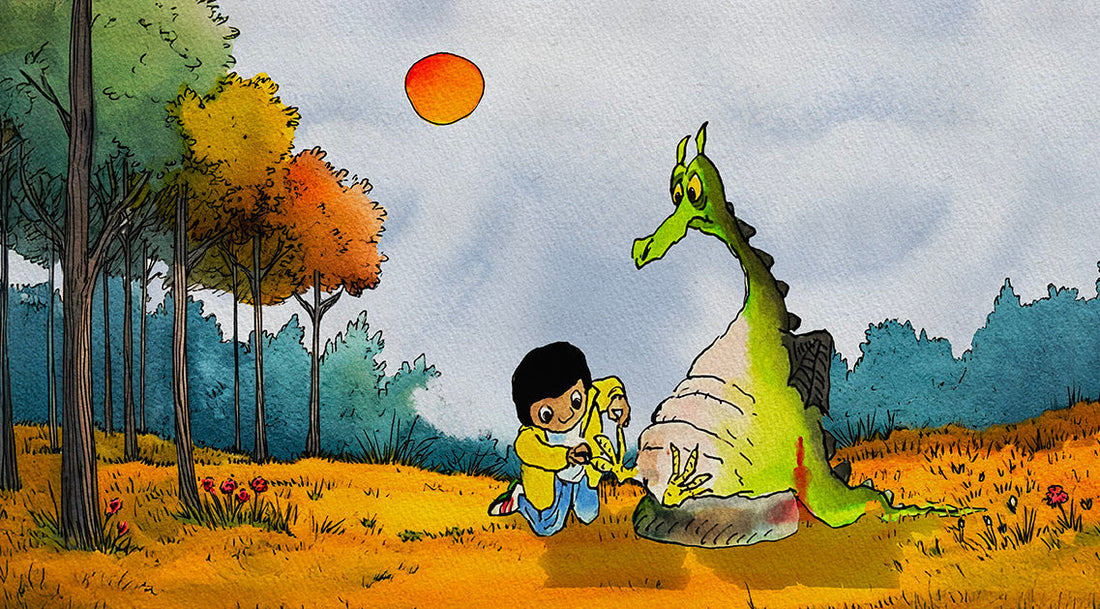
What Can a Dragon Teach Your Child About Empathy?
Janice LawrenceHow Traditional Stories Teach Emotional Courage, Kindness and Trust
Fairy tales don’t just entertain — they teach. When children listen to stories like The Kind Boy Saves the Dragon, they begin to understand what it means to care for someone else’s feelings. These emotional lessons stick because they’re memorable..
Kindness changes everything. When children see a character offer kindness without being asked — especially to someone scary or misunderstood — they learn to do the same.
Understanding others builds connection. Empathy deepens when kids imagine what someone else is going through. It helps them tune into other people’s feelings, even without words.
Trust is built on care and memory. Empathy teaches kids that what we do for others matters. The bonds we build today return to us in unexpected, powerful ways.
Courage is part of empathy, too. Being kind sometimes means standing up to unfairness. When kids see a character do that, they learn to be brave in their own way.

In The Kind Boy Saves the Dragon, a gentle king is cast out of his own land — not for doing harm, but for being too kind. His councillors have grown selfish and suspicious of his generosity, and they send him away. Still, the boy doesn’t stop believing in helping others. So when he meets a massive, wounded dragon, he doesn’t run or fight. He listens. He gently removes the splinter from its paw, bandages the wound, and offers comfort — expecting nothing in return. Later, when the boy is captured and thrown into a pit to fight a dragon, it turns out to be the very one he once helped. Recognizing his friend, the dragon lets him climb and his back flying him from danger and burns the cruel king’s throne to ash. In the end, it’s not strength or power that saves the boy — it’s the empathy he showed when no one else would, remembered and returned when he needed it most.
How Stories Grow Empathy
Fairy tales introduce children to characters in pain, in trouble, or in need of help. By identifying with these characters, children learn to name their own feelings and imagine the emotions of others. These “practice runs” in empathy become emotional tools they carry into real life.
Here's Why...
Flip the Script. When the kind boy helps a wounded dragon instead of running away, it shows kids that empathy starts with curiosity — the choice to look past what’s scary or unfamiliar and ask, “What’s really going on here?” Without this, children may grow cautious or cold around others who are different, missing chances for connection. But when they learn to look again with compassion, they start building bridges — not walls.
Feel What Others Feel. The boy helps the dragon without asking for anything, and the dragon later returns that care without being told. This shows how empathy works silently — through feelings shared, not favors owed. Kids who can’t tune into others’ emotions often struggle to keep friendships. But those who learn to notice, listen, and respond become the ones others trust and seek out.

Kindness Comes Back Around. When the dragon saves the boy, it’s not out of duty — it’s gratitude. Empathy teaches that relationships are built on care, not deals. Children who expect something in return for every kind act may feel disappointed or left out. But those who give generously — and understand how trust grows over time — tend to form the deepest, most lasting bonds.
Bravery Makes Empathy Real. Empathy isn’t always easy. The boy stays kind even when punished for it, and kids need to see that. Without courage, they may go quiet when something feels wrong. But with empathy and moral bravery working together, they find the strength to speak up, stand beside others, and stay true to themselves — even when it’s hard.
Try It Out
1. Read the The Kind Boy Saves the Dragon aloud or watch the Read-Along video.(Scroll down the page to find Watch the Video Button.)
2. Pause during emotional turning points and name what the characters might be feeling.
Ask: “What do you think he felt when he saw the dragon was hurt?”
Ask: “How do you think the dragon felt when he saw the boy again in the pit?”
3. Talk about big emotions like fear, rejection, and loyalty.
Ask: “Have you ever felt left out or misunderstood like the boy?”
Ask: “Why do you think the dragon remembered the boy’s kindness?”
4. Relate the story to your child’s life.
Ask: “What do you think it feels like when someone really sees you and cares about you?”
Ask: “Would you want a friend like the dragon?”
5. Ask reflective, brave-hearted questions.
Ask: “What would you have done if you were thrown into the pit?”
Ask: “What does it mean to do the right thing even when no one’s watching?”
6. Model empathy by sharing your own stories. Tell your child about a time you showed kindness to someone — or when someone surprised you with care. Let them learn that empathy works in real life, not just in fairy tales.
TIPS
Don’t rush to explain the lesson. Let your child discover it.
Dig deeper. If your child says, “But dragons are bad,” ask why they think that — and what made this story different.
Read the story again. Empathy builds with repetition and reflection.
Stop 'n' Think
Empathy is not just listening, it’s asking: “How can I help?” What would your child do if they met someone the whole world feared — and saw they were hurting?

Want to help your child build the skills for building lasting friendships?
Start with The Kind Boy Saves the Dragon — a beautifully illustrated tale that helps children learn how kindness can change the world.
